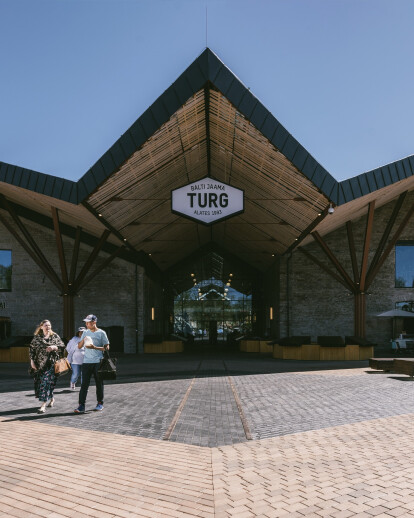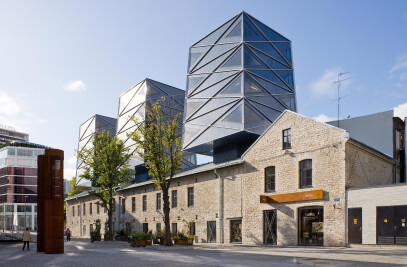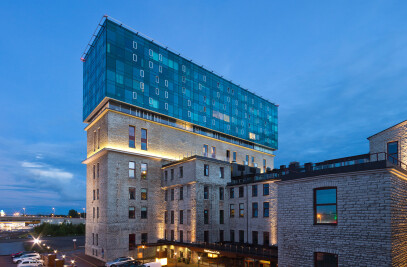Reconstruction of the characterful historic market between Tallinn’s main railway station and Kalamaja The Baltic Station market is located in north Tallinn between the city’s main railway station and the popular residential district of Kalamaja. The nostalgic market, famous since 1993 for offering exotic post-Soviet experiences - especially for tourists - was quite the attraction with its colourful selection of merchandise. In addition to reasonably priced groceries, visitors could find anything from Soviet era vintage clothing, everyday items and toys to used sanitary fittings, tools and plumbing equipment. The second-hand stalls were a goldmine for vintage clothing and music fans.
At the beginning of 2016 the market closed for renovations. In order to avoid losing the vibe of the marketplace and not disrupt the lives of vendors and customers alike, the developer offered a solution by moving the market to the neighbouring plot.
The aim of the reconstruction design was to create a contemporary and diverse market, while also preserving the historic character of the market with all of its hustle and bustle and chaotic nature. We added to the pre-existing context to attract the widest target audience possible - from rail passengers to local residents, young people to tourists, and everyone who happens to be passing through the area.
The main architectural facade of the market is made up of three two-storey limestone warehouses from the 1870s, the function of which changed in the 1990s when the market was opened. The underlying architectural idea for the new market was to draw attention to these powerful structural elements. The new extension essentially includes a cross-section of a large saw-tooth roof and a gradual longitudinal section, following the shape and size of the original buildings. The tops of the saw-tooth roof are made of polarised glass, allowing generous sunlight into the building, without it harming the goods, vendors, or customers.
The interior market is laid out over three floors within the reconstructed buildings and between them. The Baltic station side of the roof is left open for an outdoor market, which, just like the original market, closes for the night. As the archetype of visitors’ expectations, the outdoor market is placed in the most visible location to entice passers-by. Behind the outdoor market stand wooden kiosks, designated for smaller businesses, such as bakers, sweet shops, spice shops etc.
Next to the outdoor market at the front is the Hommikuväljak (Morning Square) with the Õhtuväljak (Evening Square) on the other side of the building – their names referring to the best time of the day to spend time in either. The squares are connected by ramps and terraces, lined with cosy areas for eating and sitting, a children’s playground, and terraces for cafés and restaurants. During the evenings and into the night people can walk through and enjoy the same area lit-up.
The main objective of the market’s ground floor is to convey the hustle and bustle, characteristic to markets across the globe. The desired environment is created through the massing of various market forms, brought together on the ground floor. Typical functions of a market – stalls for meat, fish, and dairy – stand side by side with the farmers market, vegetable stalls, and a street food avenue in the central building. Combining these functions creates an entirely new way to experience the Baltic Station Market.
The first floor is mainly dedicated to the essentials of the former market – antiquities, second-hand goods and clothing – but as a new addition there is also Estonian design, craft and household goods. High roomy wood-strip ceilings and ample natural light create an open airy environment throughout the whole first floor, with just a touch of extra comfort. To make use of the wonderful views from the first floor, an eatery and brewery have been installed there, both of which have an outside terrace opening to the midday sun.
When it comes to the interior architecture, emphasis is placed on displaying the history of the former warehouses and the new details that will become historic for posterity. Creating brand new historical-looking details was consciously avoided. The material palette includes bricks of various colours and brick-sized ceramic tiles. Wood and black metal were used for the railings and shop fronts. The general lighting is warm and discreet, which makes it possible to create special lighting for specific goods and businesses, if needed.
The aim of the market’s overall design is to encourage a large number and range of sellers to find a new home and inspiration in The Baltic Station Market. The tenants are invited to explore the boundaries and find a suitable image for their business.
The reconstructed market was opened to visitors in May 2017 and saw around 230,000 visitors during its opening week.

































